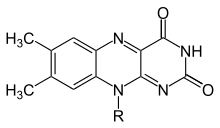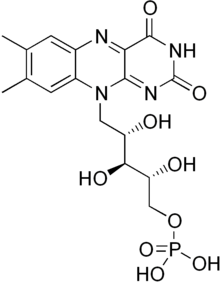Flavin group
The article'slead sectionmay need to be rewritten.The reason given is:PerMOS:INTRO,"avoid difficult-to-understand terminology" in the lead.(September 2022) |


Flavins(from Latinflavus,"yellow" ) refers generally to the class oforganic compoundscontaining the tricyclicheterocycleisoalloxazineor its isomer alloxazine, and derivatives thereof. The biochemical source of flavin is the yellow B vitaminriboflavin.The flavinmoietyis often attached with anadenosine diphosphateto formflavin adenine dinucleotide(FAD), and, in other circumstances, is found asflavin mononucleotide(orFMN), aphosphorylatedform ofriboflavin.It is in one or the other of these forms that flavin is present as aprosthetic groupinflavoproteins.Despite the similar names, flavins (with "i" ) are chemically and biologically distinct from theflavanoids(with "a" ), and theflavonols(with "o" ).
The flavin group is capable of undergoingoxidation-reduction reactions,and can accept either oneelectronin a two-step process or two electrons at once. Reduction is made with the addition ofhydrogenatoms to specificnitrogenatoms on theisoalloxazine ring system:

Inaqueous solution,flavins are yellow-coloured when oxidized, taking a red colour in the semi-reduced anionic state or blue in the neutral (semiquinone) state, and colourless when totally reduced.[1]The oxidized and reduced forms are in fastequilibriumwith the semiquinone (radical) form, shifted against the formation of the radical:[2]
- Flox+ FlredH2⇌ FlH•
where Floxis the oxidized flavin, FlredH2the reduced flavin (upon addition of two hydrogen atoms) and FlH•the semiquinone form (addition of one hydrogen atom).
In the form of FADH2,it is one of the cofactors that can transfer electrons to theelectron transfer chain.
Photoreduction
[edit]Both free and protein-bound flavins arephotoreducible,that is, able to be reduced bylight,in a mechanism mediated by several organic compounds, such as someamino acids,carboxylic acidsandamines.[2]This property of flavins is exploited by various light-sensitive proteins. For example, the LOV domain, found in many species of plant, fungi and bacteria, undergoes a reversible, light-dependent structural change which involves the formation of a bond between a cysteine residue in its peptide sequence and a bound FMN.[3]
FAD
[edit]
Flavin adenine dinucleotideis a group bound to many enzymes includingferredoxin-NADP+ reductase,monoamine oxidase,D-amino acid oxidase,glucose oxidase,xanthine oxidase,andacyl CoA dehydrogenase.
FADH/FADH2
[edit]FADH and FADH2arereducedforms of FAD. FADH2is produced as a prosthetic group insuccinate dehydrogenase,an enzyme involved in thecitric acid cycle.Inoxidative phosphorylation,two molecules of FADH2typically yield 1.5ATPeach, or three ATP combined.
FMN
[edit]
Flavin mononucleotideis aprosthetic groupfound in, among other proteins,NADH dehydrogenase,E.colinitroreductaseandold yellow enzyme.
See also
[edit]- Pteridine
- Pterin
- Deazaflavin(5-deazaflavin)
References
[edit]- ^Michaelis L, Schubert MP, Smythe CV (1936)."Potentiometric study of the flavins".Journal of Biological Chemistry.116(2): 587–607.doi:10.1016/S0021-9258(18)74634-6.Archived fromthe originalon 2009-08-08.Retrieved2008-04-25.
- ^abMassey V, Stankovich M, Hemmerich P (January 1978). "Light-mediated reduction of flavoproteins with flavins as catalysts".Biochemistry.17(1): 1–8.doi:10.1021/bi00594a001.PMID618535.
- ^Alexandre MT, Domratcheva T, Bonetti C, van Wilderen LJ, van Grondelle R, Groot ML, Hellingwerf KJ, Kennis JT (July 2009)."Primary reactions of the LOV2 domain of phototropin studied with ultrafast mid-infrared spectroscopy and quantum chemistry".Biophysical Journal.97(1): 227–37.Bibcode:2009BpJ....97..227A.doi:10.1016/j.bpj.2009.01.066.PMC2711383.PMID19580760.
Further reading
[edit]- Voet D, Voet JG (2004).Biochemistry(3rd ed.). John Wiley & Sons.ISBN0-471-39223-5.
